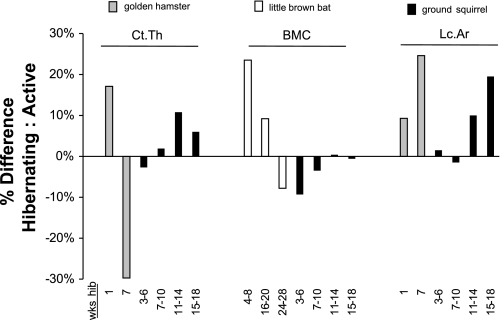Fig. 2.
Changes in bone properties of hibernating compared with active animals for small hibernators. Data are for golden hamsters (Mesocricetus auratus) (172), little brown bats (Myotis lucifugus) (20), and 13-lined ground squirrels (Spermophilus tridecemlineatus) (unpublished data). Percentage differences demonstrate the change in bone properties for hibernating animals of each species relative to active controls for different timepoints in the hibernation season. A negative percentage difference in Ct.Th and bone mineral content (BMC) suggests losses of bone structure and mineralization, as is shown for golden hamsters after 7 wk and little brown bats after 24–28 wk of hibernation. A positive percentage difference in lacunar area (Lc.Ar) also suggests bone loss during hibernation relative to periods of physical activity, as is shown for both hamsters and ground squirrels. However, compared with active animals, BMC is elevated in bats that have hibernated <20 wk, and cortical thickness is elevated in hamsters that have hibernated for 1 wk; it is unclear whether these changes are an adaptive mechanism for hibernation or a confounding effect from another variable.

